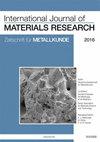正反设计范式的比较:以难熔高熵合金为例
IF 0.7
4区 材料科学
Q4 METALLURGY & METALLURGICAL ENGINEERING
引用次数: 0
摘要
先进材料的快速设计是一个具有重大科学意义的课题。传统的“向前”材料设计范式包括评估多个候选材料,以确定与目标特性匹配的最佳候选材料。然而,深度学习领域的最新进展已经为先进材料的“逆”设计范式提供了可能性,其中具有目标属性的模型能够找到最佳候选者。作为一个相对较新的概念,仍然需要系统地评估这两种范式在实际应用中的表现。因此,本研究的目的是直接、定量地比较正、逆设计建模范式。通过对两个具有不同目标和约束条件的难降解高熵合金设计案例进行分析,并将逆向设计方法与局部正向搜索、高通量筛选和多目标优化等正向方案进行比较。本文章由计算机程序翻译,如有差异,请以英文原文为准。
Comparing forward and inverse design paradigms: A case study on refractory high-entropy alloys
The rapid design of advanced materials is a topic of great scientific interest. The conventional “forward” paradigm of materials design involves evaluating multiple candidates to determine the best candidate that matches the target properties. However, recent advances in the field of deep learning have given rise to the possibility of an “inverse” design paradigm for advanced materials, wherein a model provided with the target properties is able to find the best candidate. Being a relatively new concept, there remains a need to systematically evaluate how these two paradigms perform in practical applications. Therefore, the objective of this study is to directly, quantitatively compare the forward and inverse design modeling paradigms. We do so by considering two case studies of refractory high-entropy alloy design with different objectives and constraints and comparing the inverse design method to other forward schemes like localized forward search, high-throughput screening, and multi-objective optimization.
求助全文
通过发布文献求助,成功后即可免费获取论文全文。
去求助
来源期刊
CiteScore
1.30
自引率
12.50%
发文量
119
审稿时长
6.4 months
期刊介绍:
The International Journal of Materials Research (IJMR) publishes original high quality experimental and theoretical papers and reviews on basic and applied research in the field of materials science and engineering, with focus on synthesis, processing, constitution, and properties of all classes of materials. Particular emphasis is placed on microstructural design, phase relations, computational thermodynamics, and kinetics at the nano to macro scale. Contributions may also focus on progress in advanced characterization techniques. All articles are subject to thorough, independent peer review.

 求助内容:
求助内容: 应助结果提醒方式:
应助结果提醒方式:


